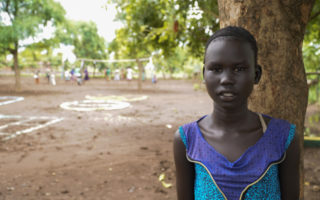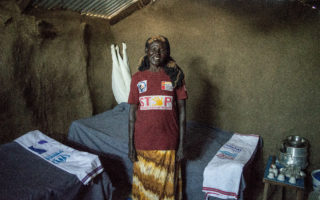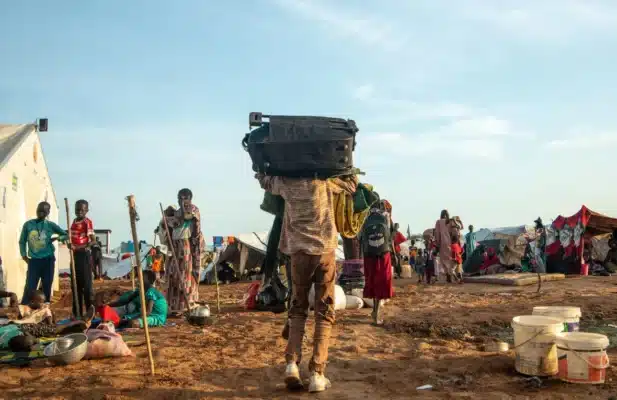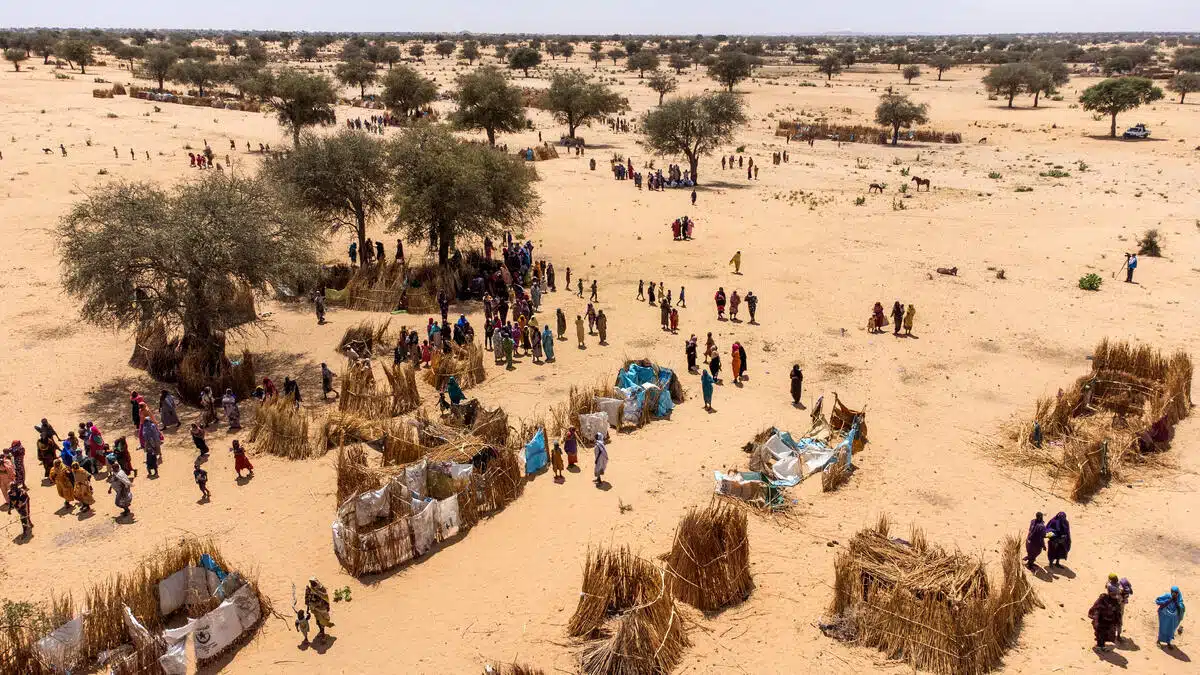
Aerial view of a makeshift settlement near the border town of Birak, where Sudanese refugees live as they wait for relocation to safer areas.© UNHCR/Ala Kheir
As Sudan’s brutal conflict reaches a grim two-year milestone, refugees continue to arrive daily in Chad, stretching the country’s resources to the limit amid reduced international funding
By Moulid Hujale in Adre in eastern Chad
“I did not think I would survive,” said Aziza , as she carefully packed her bag at a transit centre in the border town of Adré in eastern Chad. The 41-year-old mother of two children recently crossed into the country to escape war in Sudan. Together with a group of other newly arrived families, Aziza was being moved away from the border to a settlement where she could access life-saving assistance.
“I feel safe now. We don’t hear warplanes flying in the sky here,” she said, referring to the constant fear of attacks in her hometown, Nyala, in western Darfur, from which she fled.
The exodus of desperate families escaping the brutal conflict in Sudan has continued unabated since it began in April 2023, with nearly 4 million refugees now living in neighbouring countries and beyond. So far, more than 770,000 Sudanese refugees have sought safety in Chad – one of the world’s poorest countries – and 86 per cent are women and children. This is in addition to 200,000 Chadian returnees who lived in Sudan as refugees.
The new arrivals are putting immense pressure on dwindling national resources. In Adré, for example, more than 280,000 Sudanese refugees currently live in overcrowded, spontaneous sites that have sprung up along the border, overwhelming the capacity of the local population of about 40,000 people.
© UNHCR
Due to severe funding shortages, UNHCR, the UN Refugee Agency, has been forced to halt or scale back critical services, such as education and health, and the construction of new settlements away from the border where recent arrivals can be relocated. Existing settlements are struggling with inadequate infrastructure, including a lack of hospitals, schools, water and sanitation facilities.
Continuous displacement
Meanwhile, families continue to arrive daily, having endured dangerous and exhausting journeys, braving multiple checkpoints where armed men often interrogate, intimidate and extort. Many refugee women also report facing serious human rights violations, including sexual violence and abuse.
“We passed through various checkpoints where we were asked questions like ‘Who are you?’ and ‘What are you carrying?’,” Aziza recalled. “We would always respond by saying that we are ordinary people, carrying only food for our children. At one checkpoint, the driver was asked to pay a fee, which allowed us to continue our journey.”
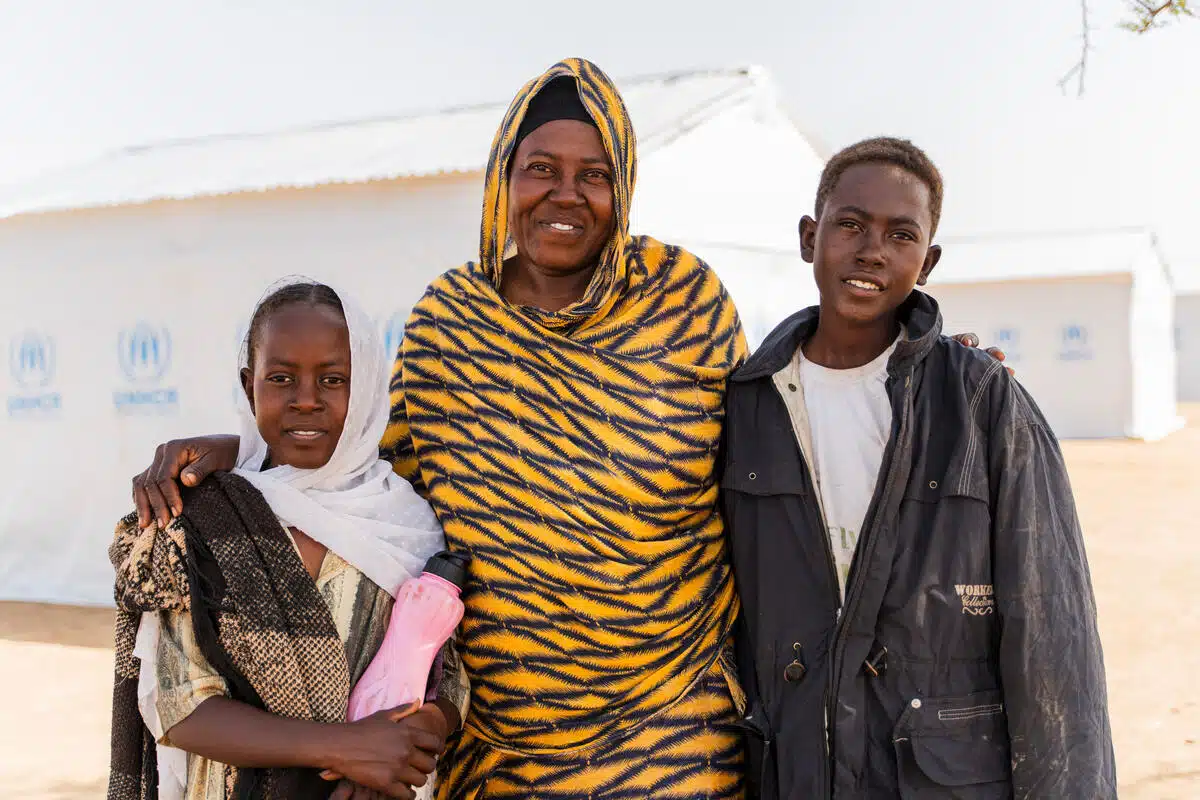
Aziza Mohamed and her two children stand in front of their new shelter in Dougui refugee settlement in eastern Chad.© UNHCR/Ala Kheir
UNHCR and its partners are on the ground, meeting refugees at the border and providing them with emergency assistance such as food, water, shelter and medical care.
While Aziza says she is lucky to have made it safely, this is not the first time she has been uprooted from her home. She spent ten years in the El-Salam camp for internally displaced people in Nyala after fleeing the deadly 2003 Darfur conflict. Her children, born in that camp, have known no other world. Most of her adult life has been shaped by violence, fear, uncertainty, and a cycle of displacement – this time across the border and separated from her family members.
“I have a brother in Nyala who could not afford transportation to escape with his family,” she said. “He has a large family of 11 children, which makes it even more difficult for him. My family is smaller, and we were able to flee the war. I could not contact him since I arrived here.”
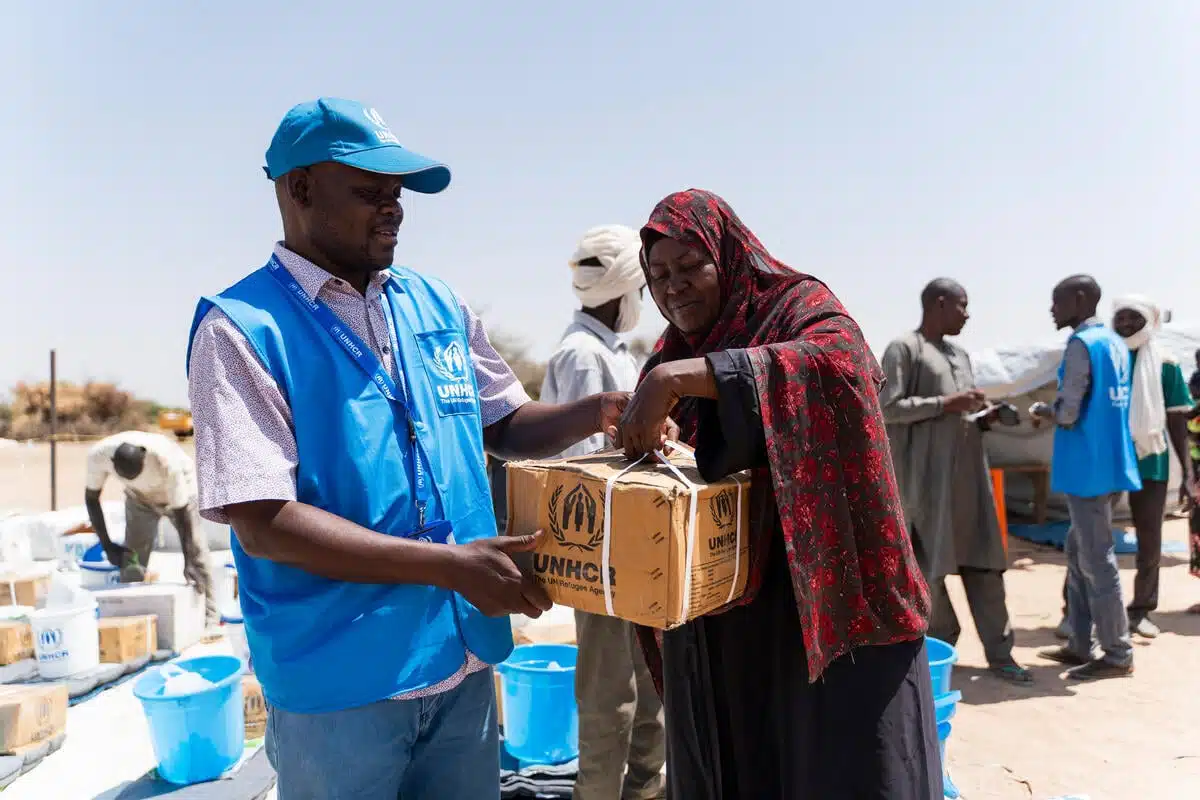
Aziza receives a package of non-food items after arriving at the Dougui refugee settlement.© UNHCR/Ala Kheir
While Chad has welcomed 1.3 million forcibly displaced people from neighbouring countries, including Sudan, the Central African Republic and Cameroon, the landlocked country was already grappling with widespread food insecurity, inter-communal conflict, and the impact of extreme weather shocks. The UN estimates that 7 million people – almost 40 per cent of the Chadian population – need humanitarian assistance.
Taking dangerous journeys
Even before the current Conflict in Sudan, Chad was hosting 400,000 Sudanese refugees who fled the 2003 Darfur violence. One of them is Aisha Ismail , who arrived in Farchana refugee settlement in 2004, aged only 12. “I was a child when I came here with my parents,” she said. “I grew up here, got married, and I now have six children. For 20 years, we kept thinking we would go back one day, but it was not safe, and now the situation is even worse.”
Aisha serves as the chairperson of the refugee community in Farchana. She advocates for better opportunities for the displaced, particularly young people who, due to limited opportunities, may end up risking the journey north to Libya and beyond in search of work and a better future.
“I am worried for my own children too,” she said. “Many young people feel desperate and may resort to dangerous journeys like crossing the Mediterranean Sea or engaging in risky gold-mining activities, which can lead to devastating outcomes.”
Aziza and Aisha’s stories are separated by two decades, yet both have been uprooted by waves of violence in Darfur. Their stories are a stark reminder of what happens when conflict goes unresolved – displacement becomes generational, and the dream of returning home slips further away.
Diminishing resources
During a visit to Chad last week, UN High Commissioner for Refugees, Filippo Grandi, lamented the fact that “the war on the other side [of the border] continues. The time has come for the military men that are waging war against their own people in Sudan to stop and for the international community to steer them in that direction.”
He added that resources to respond to the humanitarian emergency are shrinking. “If that continues, if that trend is not overturned, it means more lives lost, more suffering, and less care for people that have already undergone terrible violence,” Grandi warned.
Back at the reception centre in Adré, Aziza and her children joined other families boarding a waiting truck with their belongings while small vehicles took vulnerable people, including the sick, disabled, and elderly. After a five-hour drive on harsh, bumpy desert terrain, they arrived at the settlement – a vast, newly established site with huge lines of houses roofed with corrugated iron sheets.
After receiving essential items such as a kitchen set, blankets, mats, and a mosquito net, Aziza stood by the door of her new house, flanked by her two children.
“I am happy that I am finally here,” she said, starting the latest chapter in a long story of displacement. “I am looking forward to meeting new people in this community and reconnecting with the people we fled together with from Sudan.”
